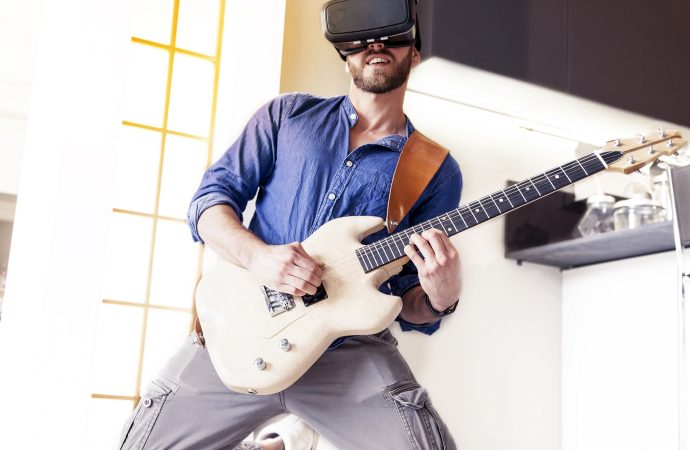Introduction Virtual Reality (VR) has revolutionized the way we interact with digital worlds, offering immersive experiences that transport users to entirely new environments. One crucial yet often underappreciated element of these experiences is music. Music in Virtual Reality (VR) is not just an accessory; it is a fundamental component that enhances immersion, guides emotional responses,
Introduction
Virtual Reality (VR) has revolutionized the way we interact with digital worlds, offering immersive experiences that transport users to entirely new environments. One crucial yet often underappreciated element of these experiences is music. Music in Virtual Reality (VR) is not just an accessory; it is a fundamental component that enhances immersion, guides emotional responses, and enriches the overall user experience. This article delves into the multifaceted role of music in VR, exploring its psychological impact, technical integration, and future potential.
The Psychological Impact of Music in VR
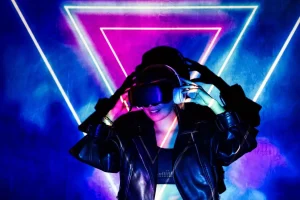
Image by: Google.com
- Emotional Resonance
Music has a profound effect on human emotions. In VR, music can amplify the emotional depth of an experience, making it more engaging and memorable. Whether it’s the haunting melodies in a horror game or the uplifting tunes in a virtual concert, music sets the tone and mood, guiding users’ emotional journeys.
- Immersion Enhancement
One of the primary goals of VR is to create a sense of presence, making users feel as though they are truly inside the virtual world. Music plays a crucial role in achieving this by providing auditory cues that complement the visual environment. Spatial audio techniques, where sound sources are placed in 3D space, further enhance this sense of immersion.
- Cognitive Focus
Music can also aid in cognitive focus. In complex VR environments, background music can help users concentrate on specific tasks or objectives. For example, rhythmic music can enhance focus and performance in VR-based training simulations or educational applications.
Technical Integration of Music in VR
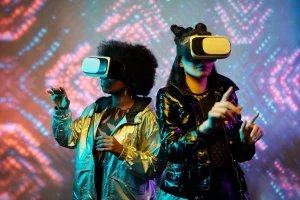
Image by: Google.com
- Spatial Audio
Spatial audio is a technique that places sound sources in a 3D space, making them appear to come from specific directions. This is crucial for VR, where sound needs to match the user’s head movements and position to maintain immersion. Advanced algorithms and software, such as binaural audio processing, are used to achieve this effect.
2. Adaptive Soundtracks
Adaptive soundtracks dynamically change based on user actions or environmental factors within the VR experience. This ensures that the music remains relevant and enhances the narrative flow. For example, the music might become more intense during a high-stakes moment in a game or mellow during a peaceful exploration phase.
3. Synchronization with Visuals
For music to be effective in VR, it must be perfectly synchronized with the visual elements. This involves meticulous planning and coordination between sound designers, composers, and VR developers. Tools like middle ware software (e.g., FMOD, Wwise) are often used to integrate music seamlessly into VR environments.
Applications of Music in Various VR Experiences
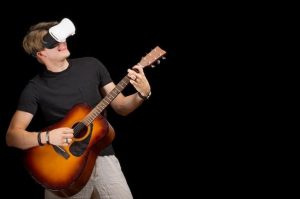
Image by: Google.com
- Gaming
In VR gaming, music is used to enhance gameplay, create atmosphere, and provide audio cues for player actions. Iconic VR games like “Beat Saber” and “Half-Life: Alyx” demonstrate how music can elevate the gaming experience.
- Virtual Concerts
Virtual concerts are becoming increasingly popular, especially in a post-pandemic world. Platforms like Wave and VR Chat host virtual music events where users can attend concerts, interact with other attendees, and even meet the artists, all within a virtual space.
- Educational Experiences
Music in educational VR applications can aid in memory retention and create a more engaging learning environment. For example, a virtual history lesson might use period-appropriate music to transport students back in time, making the experience more immersive and memorable.
- Therapeutic Uses
Music therapy is a well-established field, and its integration into VR offers new avenues for treatment. VR environments combined with therapeutic music can help in managing stress, anxiety, and even chronic pain.
Future Trends and Potential
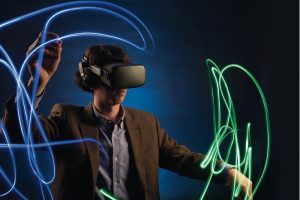
Image by: Google.com
- AI-Generated Music
Artificial Intelligence (AI) is making strides in music composition. In the future, AI-generated music could be tailored in real-time to match the user’s emotional state or actions within a VR experience, offering a highly personalized auditory experience.
- Haptic Feedback Integration
The combination of music and haptic feedback (touch sensations) can create a multi-sensory experience that enhances immersion. Imagine feeling the vibrations of a bass line through a haptic suit while attending a virtual concert.
- Cross-Platform Experiences
As VR technology continues to evolve, we can expect more cross-platform experiences where music plays a central role. These could include mixed reality (MR) and augmented reality (AR) applications, further blurring the lines between the virtual and real worlds.
Conclusion
Music in Virtual Reality is not merely an adjunct but a vital component that enhances immersion, guides emotional responses, and enriches the overall user experience. As technology continues to advance, the role of music in VR will only become more significant, offering new possibilities for creativity, engagement, and emotional connection. Whether it’s through spatial audio, adaptive soundtracks, or AI-generated compositions, the future of music in VR is incredibly promising and bound to transform the way we experience digital worlds.

